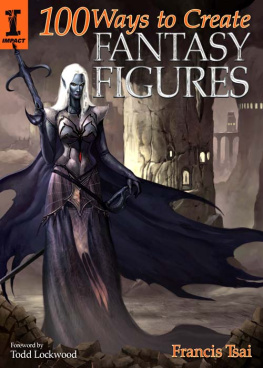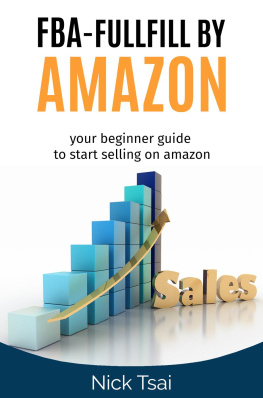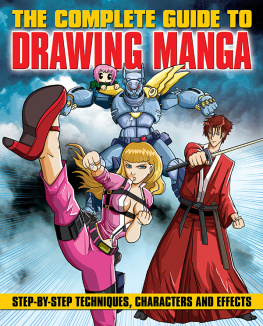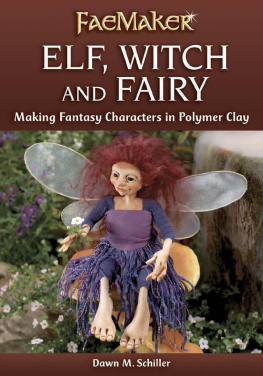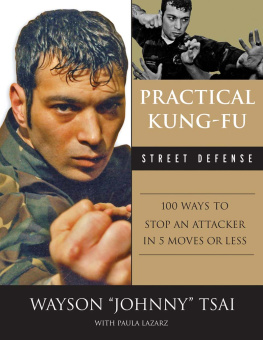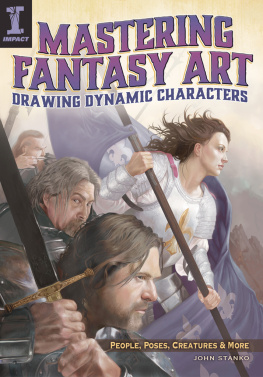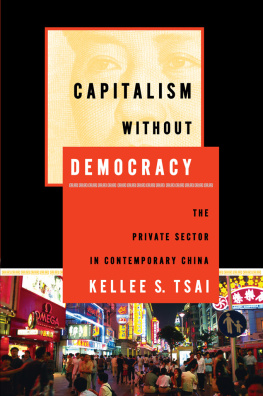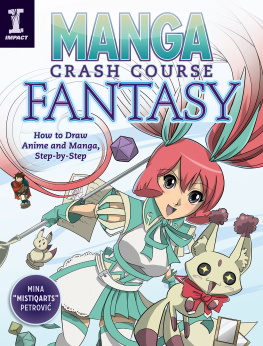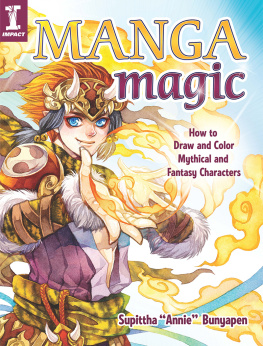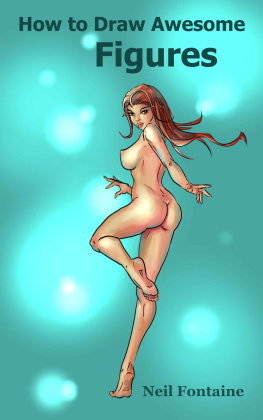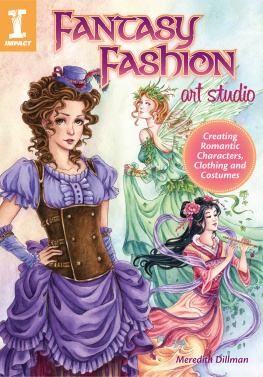Tsai - 100 ways to create fantasy figures
Here you can read online Tsai - 100 ways to create fantasy figures full text of the book (entire story) in english for free. Download pdf and epub, get meaning, cover and reviews about this ebook. City: Cincinnati, Ohio, year: 2009, publisher: F W Media;IMPACT, genre: Romance novel. Description of the work, (preface) as well as reviews are available. Best literature library LitArk.com created for fans of good reading and offers a wide selection of genres:
Romance novel
Science fiction
Adventure
Detective
Science
History
Home and family
Prose
Art
Politics
Computer
Non-fiction
Religion
Business
Children
Humor
Choose a favorite category and find really read worthwhile books. Enjoy immersion in the world of imagination, feel the emotions of the characters or learn something new for yourself, make an fascinating discovery.
- Book:100 ways to create fantasy figures
- Author:
- Publisher:F W Media;IMPACT
- Genre:
- Year:2009
- City:Cincinnati, Ohio
- Rating:3 / 5
- Favourites:Add to favourites
- Your mark:
- 60
- 1
- 2
- 3
- 4
- 5
100 ways to create fantasy figures: summary, description and annotation
We offer to read an annotation, description, summary or preface (depends on what the author of the book "100 ways to create fantasy figures" wrote himself). If you haven't found the necessary information about the book — write in the comments, we will try to find it.
100 exciting and ingenious ways to design and draw better fantasy figures - from developing characters to adding costumes, props and backdrops. Hollywood concept designer Francis Tsai shares tips and tricks for creating imaginative figures, giving readers a unique opportunity to gain guidance from a real pro.
Tsai: author's other books
Who wrote 100 ways to create fantasy figures? Find out the surname, the name of the author of the book and a list of all author's works by series.
100 ways to create fantasy figures — read online for free the complete book (whole text) full work
Below is the text of the book, divided by pages. System saving the place of the last page read, allows you to conveniently read the book "100 ways to create fantasy figures" online for free, without having to search again every time where you left off. Put a bookmark, and you can go to the page where you finished reading at any time.
Font size:
Interval:
Bookmark:

100 Ways to Create
Fantasy
Figures
Francis Tsai

This book is dedicated to: my parents Sawako and Yung-mei, to whom I owe everything; my best friend, travelling companion and soulmate Linda; my sister Marice Atsumi; and all the friends and artists who have inspired me.
A DAVID & CHARLES BOOK
Copyright David & Charles Limited 2008
David & Charles is an F+W Publications Inc. company
4700 East Galbraith Road
Cincinnati, OH 45236
First published in the UK in 2008
First published in the US in 2008
Text and illustrations copyright Francis Tsai 2008
Francis Tsai has asserted his right to be identified as author of this work in accordance with the Copyright, Designs and Patents Act, 1988.
All rights reserved. No part of this publication may be reproduced, stored in a retrieval system, or transmitted, in any form or by any means, electronic or mechanical, by photocopying, recording or otherwise, without prior
permission in writing from the publisher.
A catalogue record for this book is available from the British Library.
ISBN-13: 978-1-60061-119-3 paperback
ISBN-10: 1-60061-119-2 paperback
Printed in China by SNP Leefung
for David & Charles
Brunel House, Newton Abbot, Devon
Senior Commissioning Editor: Freya Dangerfield
Editorial Manager: Emily Pitcher
Editor: Bethany Dymond
Desk Editor: Demelza Hookway
Project Editor: Ame Verso
Proofreader: Nicola Hodgson
Art Editor: Martin Smith
Production Controller: Beverley Richardson
Visit our website at www.davidandcharles.co.uk
David & Charles books are available from all good bookshops; alternatively you can contact our Orderline on 0870 9908222 or write to us at FREEPOST EX2 110, D&C Direct, Newton Abbot, TQ12 4ZZ (no stamp required UK only); US customers call 800-289-0963 and Canadian customers call 800-840-5220.

A great many people think that art simply flows from an artists hand like sparks from a wand; that because art is emotional and evocative, it must somehow happen magically. All by itself. We hear of the Art of Hitting, the Art of Cooking, the Art of Motorcycle Maintenance, and are deluded into thinking that it is magic. That it is beyond the average man or woman.
In truth, art is the end result of knowing a craft so well that it becomes intuitive and spontaneous. It is the end result of years of growth, which, for most artists, begins the day their first crayon touches their first sheet of paper. A certain small amount of native talent is essential, but equally important is the desire to learn the rules, the inside knowledge, the tricks. Perhaps the heart and soul are the magic, but knowledge provides the incantation.
Francis Tsai is one of those magicians who knows the spells. You might almost think of the volume you hold in your hands as a spellbook, full of the newts eyes and dragons scales with which we artists ply our craft. Pore through this tome and you will see revealed the hidden parts of the trade: colour theory, perspective, anatomy, composition, value control and all the rest of the ingredients that go into brewing up one in-your-face monster, invoking a demon from the nether-world, or imbuing a hero with the courage he needs to slay a dragon.
Francis is a high-level sorcerer, and he has generously divulged his secrets here for you to behold. Pay close attention, study the recitations, practice them daily, and you too can do magic.
Todd Lockwood
If youre reading this book, you have probably had at least some interest in creating fantasy art, either professionally or just for pleasure in your spare time. I am fortunate enough to be able to make a living creating artwork for the entertainment industry, and because of this I often find myself being asked questions about it. How do you get a job as a fantasy artist? What kind of pens do you use? Is it OK to use reference material? How do you know what colours to use? And so on My path to my current career was fairly lengthy and roundabout; I didnt take the traditional art-school route, and in fact never really learned the fundamentals of illustration in any rigorous, orderly way. It was not the easiest or best way to become a working fantasy artist, and I had to study every day to fill in the gaps in my art education. After a number of years working as a concept artist in the computer games industry and as a freelance illustrator for books, comics, films and television, I have assembled a few nuggets of knowledge and some workflow routines that seem to have a certain degree of success. It is these that I want to share with you in this book.
It has never been a better time to be a fantasy artist. As I look around my studio library, I can see many examples of books and films that are fantasy related, or at least somehow influenced by this kind of imagery. Role-playing games have long been a primary source, but with all the recent advances in filmmaking technology, movies are now able to convincingly portray the kinds of worlds and beings familiar to fans of the fantasy genre. Successful films often spawn computer games and, increasingly, material can flow the other way too. This only benefits the traditional role-playing game and book markets, all of which results in more opportunities for skilled illustrators.
This book had a long genesis, which began back when I found that students and amateur artists (and even a few professionals) were asking me certain questions time and time again. I thought it might be useful to put together a list of Frequently Asked Questions on my website. The more I worked on it the longer and more involved it became, because there was just so much material to cover. With some of the topics, it was hard to convey the information without an accompanying illustration to make the point, and it quickly grew beyond that of a simple FAQ. So I set it aside.
A few years ago, I started writing some short articles about different aspects of concept art and illustration for fantasy and science fiction art magazine ImagineFX. A few of the points I originally had in my FAQ showed up in these articles, but I was usually at the end of my allotted word count before I could convey enough information. It was an interesting dilemma I could present my points in a fairly focused way that was limited in scope; or I could cover a wide variety of topics in a somewhat superficial way. So, when I was presented with the opportunity to create this book, I thought it would be a great way to impart some of the tips from the original FAQ, hopefully in a manner that is both broad in scope but also specific enough to provide some useful, practical advice based on my experience.

The preliminary sketch in most illustration jobs needs to show the art director your intentions as far as pose and composition go, and also give some idea of colour and tonal value without being too detailed or finished.
For an illustrator, tools consist of the actual equipment used to create the artwork. Until recently, these consisted solely of some variation of pencils, ink, paint and paper or canvas. However, in the past few years digital technology has advanced to the point where it can be difficult to tell the difference between art created traditionally and that made on the computer. In addition, peripheral equipment such as scanners and drawing tablets have continued to blur the boundaries between digital and traditional techniques and media.
Font size:
Interval:
Bookmark:
Similar books «100 ways to create fantasy figures»
Look at similar books to 100 ways to create fantasy figures. We have selected literature similar in name and meaning in the hope of providing readers with more options to find new, interesting, not yet read works.
Discussion, reviews of the book 100 ways to create fantasy figures and just readers' own opinions. Leave your comments, write what you think about the work, its meaning or the main characters. Specify what exactly you liked and what you didn't like, and why you think so.

